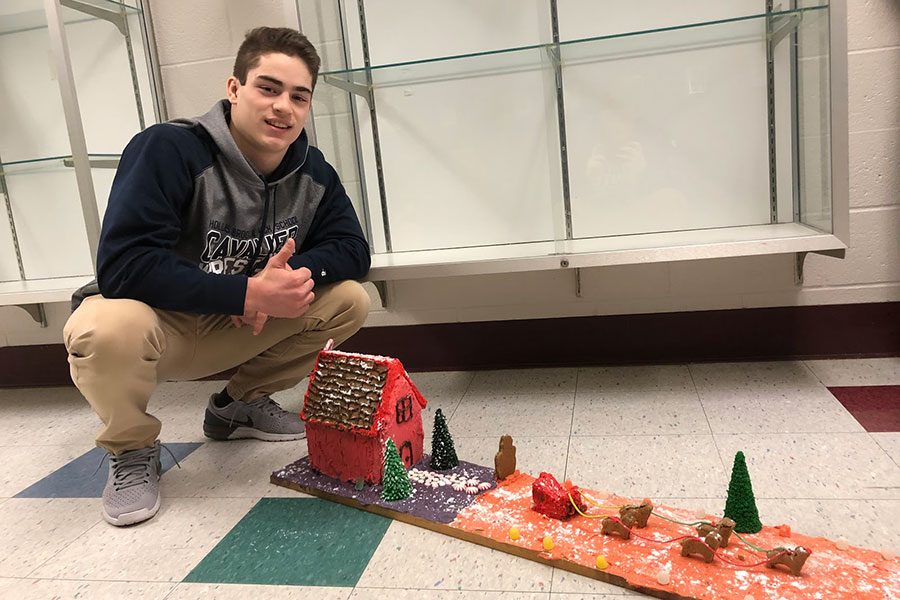Midterms: projects or tests?
Scott Anneser ‘19 stands next to his gingerbread house, a project assigned in Foods class at HBHS. “The making of the gingerbread house combined teamwork, friendship, and hard work with making food and learning. …we learned to problem solve and persevere through all the adversity. It was a great experience,” said Anneser.
December 19, 2018
As the first semester comes to an end, teachers and students alike are beginning to prepare for midterms. For students taking traditional tests, the month of January means hours of tedious studying and procrastination. For others, however, midterms are not quite as painful. Some teachers at HBHS have begun assigning projects instead of the infamous tests. By minimizing stress while still applying the semester’s material, these teachers are able to assess their students’ knowledge in a practical and engaging way.
Although midterm tests are adequate in covering all of the material taught throughout the semester, they are not always effective in gauging the competence of students. Elissa McCormick is one of the teachers at HBHS who lets students decide on the format of their midterms. McCormick finds that different students have different learning styles, so she lets the majority-rule decide in her French III classes. “[Performance] depends on the kid…some prefer not to have all the work beforehand and just study, but some students get really stressed about a big test and freak out and don’t do so well even though they did study,” McCormick said. Students can personalize their projects so that they are not limited by the pass or fail standards of tests.
By allowing students to apply the course material rather than memorizing it, projects can be a more effective method of learning for some students than traditional tests. “Real world situations given in the project are more capable to draw students’ attention and capture their interest to provoke the needed level of thinking to apply new knowledge in a problem solving context,” states Urvi Bhagi, an author for eLearning. Students inevitably become more engaged in understanding the information when they create a project.
Kyra Belden ‘19 has personally noted this stark contrast between tests and projects during midterm season. “When I make a project, I actually learn the material, but when I’m studying for a test, I’m just going through the motions,” Belden said. To prepare for tests, students often study the material on their own, and there is not much creativity involved. To prepare for projects, however, students must become hands-on with their learning and apply what they have been taught.
It is no surprise that a large sample of students expressed that they perform better on midterm projects than they do on tests. “I put more time into making the project than I would have spent studying,” said Kyle Simpson ‘19. Since projects allow students to decide the direction of their assessment, students become more engaged.
Additionally, projects also stimulate growth in areas other than the subjects of the specific class. “Projects help students learn how to work independently and discover the answers to their own questions. By also learning to complete projects in teams, students gain communication and leadership skills that they can adapt to the real world,” says Psyche Pascual, an author for GreatSchools. Projects encourage collaboration and the sharing of ideas, both extremely valuable skills for succeeding in higher education.
Projects also tend to be less stressful than midterm tests. Eric Perry, science teacher at HBHS, admits to the subsequent stress that comes with traditional tests. “They can be overwhelming if you have five back to back tests that you have to study for,” said Perry. Having multiple tests on one day requires a significant amount of memorization and puts a lot of unnecessary stress on students.
“[For tests,] you have to remember all the tiny details instead of getting to focus on the bigger picture,” said Evan Simonds ‘19. With projects, however, preparation is based around general understanding and application, so students are less pressured to remember all the insignificant details.
Although some teachers at HBHS are phasing them out, midterm tests still hold a prominent role within the school. In science and math courses, concepts are relatively black and white, so it is for teachers in these subjects to give tests rather than projects. It is difficult to create a creative project when there is only one right answer.
Additionally, standardized tests are common in college, so high school teachers feel obligated to prepare their students for the future. “The reality is that these kids are going off to higher education, and they’re going to need to sit for an exam. So it’s that sustained concentration and focus that they’ll need to be successful in college,” said Lisa Danis, an English teacher at HBHS.
Though many teachers continue to use tests for midterms for these reasons, the additional skills taught through projects are too valuable to throw away. Projects are the best alternative to engage students in their learning, as they are less stressful and teach students important skills such as problem solving, cooperation, and creativity. In the future, hopefully teachers will determine the format of their midterms, acknowledging the many benefits of using projects.















![Students in Archaeology use tools in a mock excavation. As a class that focuses on hands-on learning, students are able to gain crucial life skills. “[The class] is more hands-on than I thought, and I'm learning way more with physical activities than I do in the classroom,” said student Tess Brown ‘25.](https://cavchronline.com/wp-content/uploads/2024/11/IMG_8390-e1733078359165-278x300.jpg)
